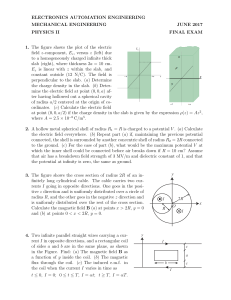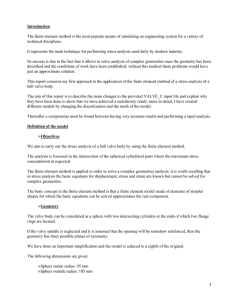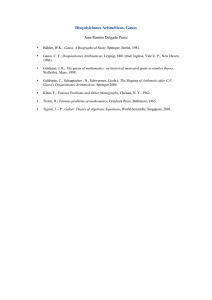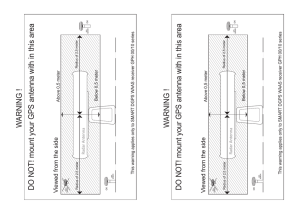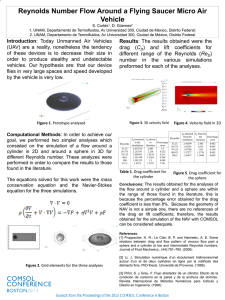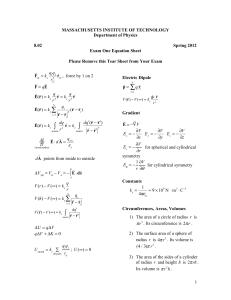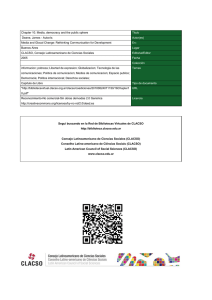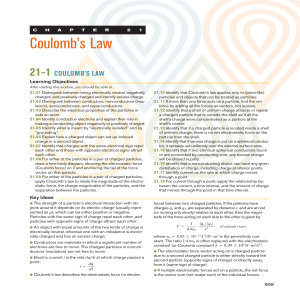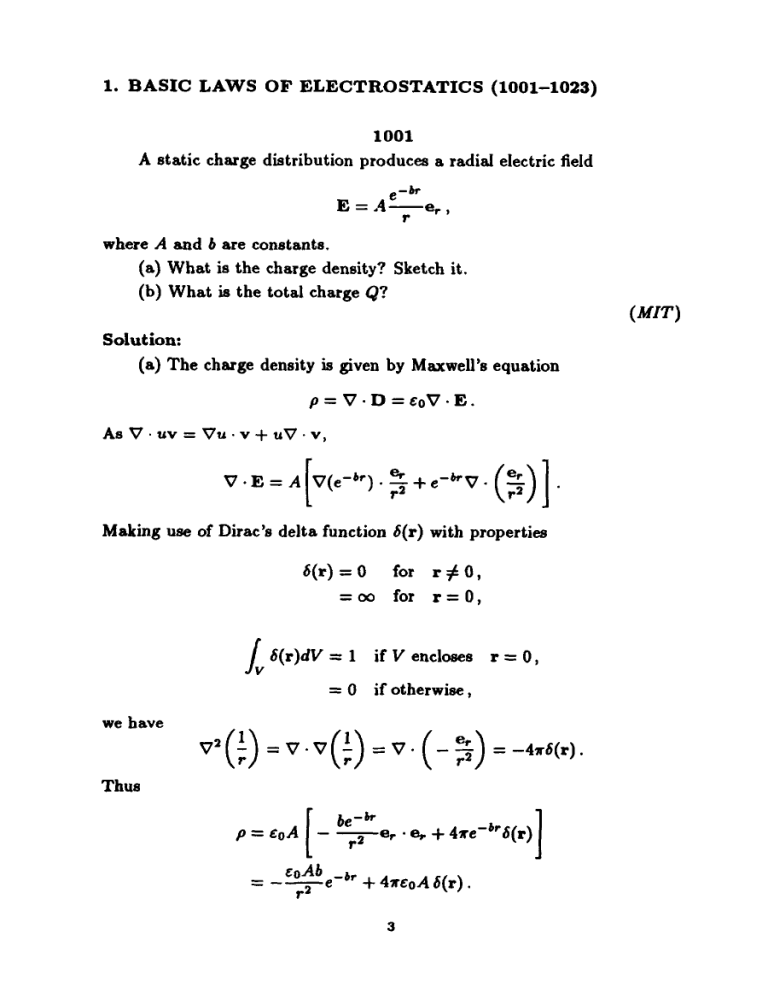
1. BASIC L A W S OF ELECTROSTATICS (1001-1023)
1001
A static charge distribution produces a radial electric field
e-k
r
E = A-e,
,
where A and b are constants.
(a) What is the charge density? Sketch it.
(b) What is the total charge Q?
Solution:
(a) The charge density is given by Maxwell’s equation
p = V . D = BOV.E.
AS V .uv = VU * V + UV ’ v ,
Making use of Dirac’s delta function 6(r) with properties
6(r)=O for r # O ,
= o o for r=O,
J, 6(r)dV = 1
if
v encloses
= 0 if otherwise,
Thus
3
r = 0,
4
Problems U Solmiionr on Elcdromagnciirm
Hence the charge distribution consists of a positive charge 4rsoA at the
origin and a spherically symmetric negative charge distribution in the surrounding space, as shown in Fig. 1.1.
Fig. 1.1
(b) The total charge is
It can also be obtained from Gauss' flux theorem:
Q = r-wx
lim f a o E - d S
in agreement with the above.
1002
Suppose that, instead of the Coulomb force law, one found experimentally that the force between any two charges q1 and 42 was
where a is a constant.
(a) Write down the appropriate electric field E surrounding a point
charge q.
(b) Choose a path around this point charge and calculate the line
integral f E dl. Compare with the Coulomb result.
(c) Find f En dS over a spherical surface of radius r1 with the point
charge at this center. Compare with the Coulomb result.
(d) Repeat (c) at radius r1 + A and find V .Eat a distance rl from the
point charge. Compare with the Coulomb result. Note that A is a small
quantity.
( Wisconsin)
-
Solution:
(a) The electric field surrounding the point charge q is
E(r) = -- I (I - f i l e r ,
h e 0 r2
where r is the distance between a space point and the point charge q, and
er is a unit vector directed from q to the space point.
Fig. 1.2
(b) As in Fig. 1.2, for the closed path L we find
6
Problemr
d
Solviionr on Eleciromrgnciirm
and
From Coulomb’s law
of the point charge
Fl2
= a e r , z we
t can obtain the electric field
?!
E(r) = -
4mOr2er
*
Clearly, one has
AE.dl=O.
So the Coulomb result is the same as that of this problem.
(c) Let S be a spherical surface of radius rl with the charge q at its
center. Defining the surface element dS = dSe,, we have
= -4( l - f l ) .
&O
From Coulomb’s law and Gauss’ law, we get
The two results differ by $-.
(d) Using the result of (c), the surface integral at rl
+ A is
l and Sz with radii
Consider a volume V’ bounded by two spherical shells S
r = r1 and r = rl + A respectively. Gauss’ divergence theorem gives
f
SI+Sa
E . dS =
l,
V.EdV.
Ae the directions of dS on S1 and Sz are outwards from V', we have for
small A
As
;4f < 1, we can approximately set
-
Thus one gets
On the other hand, Coulomb's law would give the divergence of the electric
field produced by a point charge q as
V . E(r) = -6(r).
4
€0
1003
Static charges are distributed along the z-axis(one-dimensional) in the
z' 5 a. The charge density is
interval -a
<
(a) Write down an expression for the electrostatic potential @(z)at a
point z on the axis in terms of p(z').
(b) Derive a multipole expansion for the potential valid for z > a.
(c) For each charge configuration given in Fig. 1.3, find
(i) the total charge Q = Jpdz',
(ii) the dipole moment P = Jz'pdz',
(iii) the quadrupole moment Qoo = 2 J d2pdz',
(iv) the leading term (in powers of l/z) in the potential CP at a
point z > a.
( Wisconsin)
8
Problem. €4 S o l r i i o n r o n E l e c i r o m a g n e t i r m
Solution:
(a) The electrostatic potential at a point on z-axis is
(b) For c > a , a > 2'
> -a, we have
--1
12-
2
'
1
1
2
'
2'2
2
22
23
- -+-+-+...
.
Hence the multipole expansion of @(z) is
(c) The charge configuration (I) can be represented by
P(4 =q
W )9
for which
(i) Q = q ;
(ii)
P = 0 ; (iii) QEE= 0 ; (iv) O(z) = -. 9
4'X&oX
The charge configuration (11) can be represented by
for which
(i) Q = 0 ; (ii) P = go;
(iii)
Qlo = 0; (iv) O(z) = -- qa
4Ir€ot2
*
9
The charge configuration (111) can be represented by
for which
(i) Q = 0 ; (ii) P = 0 ; (iii)
QOE
paZ
= qa2 ; (iv) *(z) = -
8reox3
1004
Two uniform infinite sheets of electric charge densities +a and --4
intersect at right angles. Find the magnitude and direction of the electric
field everywhere and sketch the lines of E.
( Wisconsin)
Solution
First let us consider the infinite sheet of charge density +a. The magnitude of the electric field caused by it at any space point is
The direction of the electric field is perpendicular to the surface of the
sheet. For the two orthogonal sheets of charge densities fa,superposition
of their electric fields yields
E = -a
. -4
2EO
The direction of E is as shown in Fig. 1.4.
Fig. 1.4
Problcmr E/ Soluiionr on Eleciromogneiirm
10
1005
Gauss’ law would be invalid if
(a) there were magnetic monopoles,
(b) the inversesquare law were not exactly true,
(c) the velocity of light were not a universal constant.
(CCT)
Solution:
The answer is (b).
1006
An electric charge can be held in a position of stable equilibrium:
(a) by a purely electrostatic field,
(b) by a mechanical force,
(c) neither of the above.
(CCT)
Solution:
The answer is (c).
1007
If P is the polarization vector and E is the electric field, then in the
equation P = aE,a in general is:
(a) scalar, (b) vector, (c) tensor.
VCT)
Solution:
The answer is (c).
1008
(a) A ring of radius R has a total charge +Q uniformly distributed on
it. Calculate the electric field and potential at the center of the ring.
Elcc troitotier
11
(b) Consider a charge -Q constrained to slide dong the axis of the
ring. Show that the charge will execute simple harmonic motion for small
displacements perpendicular to the plane of the ring.
( Wisconsin)
Solution:
As in Fig. 1.5, take the z-axis along the axis of the ring. The electric
field and the potential at the center of the ring are given by
*Q
Fig. 1.5
The electric field at a point P on the z-axis is given by
E(z) =
Qz
h & o (R2-k Z2)3/2eg
Thus a negative charge -Q at point p is acted upon by a force
F(z) = -
Q2 Z
+
cine4 R2 z2)3/1e*
As z < R, F ( t ) a P and -Q will execute simple harmonic motion.
1009
An amount of charge q is uniformly spread out in a layer on the surface
of a disc of radius a.
(a) Use elementary methods based on the azimuthal symmetry of the
charge distribution to find the potential at any point on the axis of sym
metry.
Problems & Sofuiionr o n E~ccfromognetirm
12
r(1.I
(b) With the aid of (a) find an expression for the potential at any point
> a) as an expansion in angular harmonics.
( Wisconsin)
S o ht ion:
(a) Take coordinate axes as in Fig. 1.6 and consider a ring formed by
circles with radii p and p dp on the disc. The electrical potential at a
point (0, 0, z) produced by the ring is given by
+
Integrating, we obtain the potential due to the whole ring:
z
t
Fig. 1.G
(b) At a point
solution
1.1 >
a, Laplace's equation V2cp = 0 applies, with
0 for r + 00, we have an = 0.
In the upper half-space, P > 0, the potential on the axis is 'p = p(r, 0).
As Pn(l.)= 1, we have
As
'p -+
n=O
Elcctrostaiicr
13
In the lower half-space, z < 0, the potential on the axis is
Pn(-l) =
we have
'p
= ' p ( r , r ) ,As
W
Using the results of (a) and noting that for a point on the axis1.1 = z , we
have for z > 0
However, as
1(1- 1). . .. ..
+ 2
n!
(3 - n + 1)
G)'+...
a2
1 .
the equation becomes
Comparing the coefficients of powers of r gives
Hence, the potential at any point r of the half-plane z
> 0 is given by
14
Problemt fi Solutionr on Elecfromagneiirm
Similarly for the half-plane z < 0, as (-l)2n-z = 1 we have
Thus the same expression for the potential applies t o all points of space,
which is a series in Legendre polynomials.
1010
A thin but very massive disc of insulator has surface charge density (I
and radius R. A point charge +Q is on the axis of symmetry. Derive an
expression for the force on the charge.
( Wisconsin)
Solution:
Refer to Problem 1009 and Fig. 1.6. Let Q be at a point (O,O,z ) on
the axis of symmetry. The electric field produced by the disc at this point
is
whence the force on the point charge is
By symmetry the direction of this force is along the axis of the disc.
1011
The cube in Fig. 1.7 has 5 sides grounded. The sixth side, insulated
from the others, is held at a potential 40. What is the potential at the
center of the cube and why?
(MIT)
E/ecirodtoticd
15
Fig. 1.7
Solution:
The electric potential qic at the center of the cube can be expressed as
a linear function of the potentials of the six sides, i.e.,
i
where the Ci’s are constants. As the six sides of the cube are in the same
relative geometrical position with respect to the center, the Ci’s must have
the same value, say C. Thus
If each of the six sides has potential 40, the potential at the center will
obviously be 4 0 too. Hence C = 3. Now as the potential of one side only
is 40 while all other sides have potential zero, the potential at the center is
40/6.
1012
A sphere of radius R carries a charge Q,the charge being uniformly
distributed throughout the volume of the sphere. What is the electric field,
both outside and inside the sphere?
( Wisconsin)
Solution:
The volume charge density of the sphere is
16
Prollemr 13Solmiionr on Eltctwmr~rrtirm
Take as the Gaussian surface a spherical surface of radius r concentric with
the charge sphere. By symmetry the magnitude of the electric field at all
points of the surface is the same and the direction is radial. From G a u d
law
f E . d s = --/pdv
1
€0
we immediately obtain
1013
Consider a uniformly charged spherical volume of radius R which contains a total charge &. Find the electric field and the electrostatic potential
at all points in the space.
( Wisconsin)
S o htion:
Using the results of Problem 1012
and the relation between electrostatic field intensity and potential
P ( P ) = JP r n E - 4
we obtain
c . l ( r ) = lR E l . d r + L r n E 2 . d r
Qrdr
* Qdr
17
Eleciroririier
1014
For a uniformly charged sphere of radius R and charge density p,
(a) find the form of the electric field vector E both outside and inside
the sphere using Gauss' law;
(b) from E find the electric potential Q using the fact that Q -+ 0 as
r+oo.
( Wisconsin)
Solution:
(a) Same as for Problem 1013.
(b) Referring to Problem 1013,we have
for r > R , q i = - R3P
3eor '
for
1015
In the equilibrium configuration, a spherical conducting shell of inner
radius a and outer radius b has a charge q fixed at the center and a charge
density u uniformly distributed on the outer surface. Find the electric field
for all r, and the charge on the inner surface.
( Wisconsin)
Solution:
Electrostatic equilibrium requires that the total charge on inner surface
of the conducting shell be - q . Using Gauss' law we then readily obtain
E(r) =
E=O
1
4r&or2er
for r < a ,
for a
< r < 6,
1 4rb2a
ab2
E(r) = -- e, = for r > 6.
€ 0 r2 er
4rcO r2
1016
A solid conducting sphere of radius rl has a charge of +Q. It is surrounded by a concentric hollow conducting sphere of inside radius r2 and
Problem. t3 Soluiionr on Electromagnciirm
18
outside radius 1-3. Use the Gaussian theorem to get expressions for
(a) the field outside the outer sphere,
(b) the field between the spheres.
(c) Set up an expression for the potential of the inner sphere. It is not
necessary to perform the integrations.
( Wisconsin)
Solution:
Because of electrostatic equilibrium the inner surface of the hollow
conducting sphere carries a total charge -8, while the outer surface carries
a total charge +Q.Using Gauss’ law
i E . d S = - Qtot
-,
€0
where Qtot is the algebraic sum of all charges surrounded by a closed surface
s, we obtain
(a)
~ ( r =) +er
(r >r3)
(b)
E(r) = &er
(f2
> r > r1)
(c) Using the expression for the potential cp(p) =
potential of the inner sphere:
r,”E - d ,we find the
1017
The inside of a grounded spherical metal shell (inner radius R1 and
outer radius Rz) is filled with space charge of uniform charge density p. Find
the electrostatic energy of the system. Find the potential at the center.
( Wisconsin)
S o htion:
Consider a concentric spherical surface of radius r(r
Gauss’ law we get
< R l ) . Using
1s
Eleetrortatier
As the shell is grounded, p(R1) = 0, E = O(r > Rz). Thus
The potential at the center is
The electrostatic energy is
1018
A metal sphere of radius a is surrounded by a concentric metal sphere
of inner radius b, where b > a. The space between the spheres is filled
with a material whose electrical conductivity u varies with the electric field
strength E according to the relation u = K E , where K is a constant. A
potential difference V is maintained between the two spheres. What is the
current between the spheres?
( Wisconsin)
Solution:
Since the current is
the electric field is
and the potential is
Hence the current between the spheres is given by
I = 4 r K V’/ ln(b/a)
.
20
Problcmr EI Solulionr o n E/cciromi#neiirm
1019
An isolated soap bubble of radius 1 cm is at a potential of 100 volts. If
it collapses to a drop of radius 1 mm, what is the change of its electrostatic
energy?
( Wisconsin)
Solution:
If the soap bubble carries a charge Q, its potential is
For r = rl = 1 cm, V = V1 = 100 V,we have Q = 4ueorlV1. As the radius
changes from rl to r2 = 1 mm, the change of electrostatic energy is
= 5 x lo-" J
.
1020
A static electric charge is distributed in a spherical shell of inner radius
R1 and outer radius K2. The electric charge density is given by p = u br,
where r is the distance from the center, and zero everywhere else.
(a) Find an expression for the electric field everywhere in terms of T.
(b) Find expressions for the electric potential and energy density for
t < R I . Take the potential to be zero at r -+ 00.
(SUNY, Buflalo)
+
Solution:
Noting that p is a function of only the radius r, we can take a concentric
spherical surface of radius r as the Gaussian surface in accordance with the
symmetry requirement. Using Gauss' law
f E . dS = -1 / p(r)dr ,
I
€0
21
Electrortolicr
we can get the following results:
(a) Electric field strength.
For r < R1, El = 0.
For R1 < r < R2, using the relation 4rr2E2 = Jil(a 6r')f2df
we find
6
l a
E2 = -[-(r3 4(r4 - R;')].
.
5
cOr3
3
a(::J
For Rz > r, from 4ar2E3 =
+
e)+
+ br')r'2dr' we get
(b) Potential and the energy density for r < Rt.
Noting that cp(00) = 0, the potential is
cp(r) =
lrn (lR'+hr
E dl =
+L:)E
-dr
Also, as El = O(r < R , ) , the energy density for r < R1 is
w=$E?=O.
1021
An electric charge Q is uniformly distributed over the surface of a
sphere of radius r. Show that the force on a small charge element dq ie
radial and outward and is given by
1
d F = TEdq,
where E = &-$ is the electric field at the surface of the sphere.
( Wisconsin)
Solution:
The surface charge density is given by
22
Problemr d Solvlionr on Eleclromognelirm
As shown in Fig. 1.8, we consider a point P inside the sphere cloee to an
area element ds. The charge dq on this area element will produce at the
point P an electric field which is approximately that due to a uniformly
charged infinite plate, namely,
where n is a unit vector normal to ds in the outward direction.
Fig. 1.8
The electric field is zero inside the sphere. Hence, if we take E2p as
the electric field at P due to all the charges on the spherical surface except
the element ds, we must have
Therefore,
As P is close to ds, E2p may be considered as the field strength at ds due
to the charges of the spherical surface. Hence, the force acting on de is
1
2
dF = dqE2p = - E d q n ,
where E = Q/4r60r2 is just the field strength on the spherical surface.
1022
A sphere of radius R1 has charge density p uniform within its volume,
except for a small spherical hollow region of radius R2 located a distance a
from the center.
23
Elceirorioiier
(a) Find the field E at the center of the hollow sphere.
(b) Find the potential q5 at the same point.
( VC,Berkeley)
Solution:
(a) Consider an arbitrary point P of the hollow region (see Fig. 1.9)
and let
O P = r , Q'P=r', 0 0 ' = a ,
r'=r-a.
Fig. 1.9
If there were no hollow region inside the sphere, the electric field at the
Doint P would be
If only the spherical hollow region has charge density p the electric field at
P would be
E2 = L r ' .
3.50
Hence the superposition theorem gives the electric field at P as
Thus the field inside the hollow region is uniform. This of course includes
the center of the hollow.
(b) Suppose the potential is taken to be zero at an infinite point. Consider an arbitrary sphere of radius R with a uniform charge density p . We
can find the electric fields inside and outside the sphere as
E(r) =
{
El
r<R,
&r,
r>R.
24
Problems El Soluiionr on Eleciromagncfism
Then the potential at an arbitrary point inside the sphere is
where r is the distance between this point and the spherical center.
Now consider the problem in hand. If the charges are distributed
throughout the sphere of radius R1, let 41 be the potential at the center
0‘ of the hollow region. If the charge distribution is replaced by a small
sphere of uniform charge density p of radius R2 in the hollow region, let the
potential at 0’ be 4 2 . Using (1) and the superposition theorem, we obtain
P
40) = 41 - 4’ = -(3R;
660
P
= -[3(R:
660
P
- a’) - -(3G
6EO
- 0)
- R:) - a ’ ] .
1023
The electrostatic potential a t a point P due t o an idealized dipole layer
of moment per unit area T on surface S is
where r is the vector from the surface element to the point P.
(a) Consider a dipole layer of infinite extent lying in the z-y plane of
uniform moment density T = re,. Determine whether 4 or some derivative
of it is discontinuous across the layer and find the discontinuity.
(b) Consider a positive point charge q located at the center of a spherical surface of radius a. On this surface there is a uniform dipole layer T
and a uniform surface charge density u. Find T and u so that the potential inside the surface will be just that of the charge q , while the potential
outside will be zero. (You may make use of whatever you know about the
potential of a surface charge.)
(SVNY, Buflalo)
Solution:
(a) By symmetry the electrostatic potential a t point P is only dependent on the z coordinate. We choose cylindrical coordinates (R, 8 , z) such
25
that P is on the z-axis.Then the potential at point P is
As r2 = Ra -+ t 2 dS
,
= 2rRdR, we get
Hence, the electrostaic potential is discontinous across the 2-y plane (for
which z = 0). The discontinuity is given by
(b) It is given that 4 = 0 for r > a. Consequently E = 0 for r > a.
Using Gauss’ law
E - d S = -Q,
4
we find that u 4ra2
EO
+ q = 0. Thus
If the potential at infinity is zero, then the potential outside the spherical
surface will be zero everywhere. But the potential inside the sphere is
p=
For r = a , p = &, so that the discontinuity at the spherical
surface IS
&.
--
A4 = --. 4
We then have
2=
4rcoa I
4reoa
giving
T
4
= --e,.
4ra

